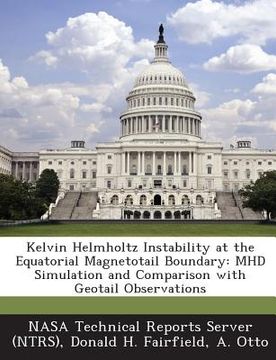Compartir
Kelvin Helmholtz Instability at the Equatorial Magnetotail Boundary: Mhd Simulation and Comparison with Geotail Observations (en Inglés)
Nasa Technical Reports Server (Ntrs)
(Autor)
·
Donald H. Fairfield
(Autor)
·
A. Otto
(Autor)
·
Bibliogov
· Tapa Blanda
Kelvin Helmholtz Instability at the Equatorial Magnetotail Boundary: Mhd Simulation and Comparison with Geotail Observations (en Inglés) - Fairfield, Donald H. ; Otto, A. ; Nasa Technical Reports Server (Ntrs)
$ 22.53
$ 37.56
Ahorras: $ 15.02
Elige la lista en la que quieres agregar tu producto o crea una nueva lista
✓ Producto agregado correctamente a la lista de deseos.
Ir a Mis Listas
Origen: Estados Unidos
(Costos de importación incluídos en el precio)
Se enviará desde nuestra bodega entre el
Miércoles 14 de Agosto y el
Miércoles 21 de Agosto.
Lo recibirás en cualquier lugar de Internacional entre 1 y 3 días hábiles luego del envío.
Reseña del libro "Kelvin Helmholtz Instability at the Equatorial Magnetotail Boundary: Mhd Simulation and Comparison with Geotail Observations (en Inglés)"
On March 24, 1995 the Geotail spacecraft observed large fluctuations of the magnetic field and plasma properties in the Low Latitude Boundary Layer (LLBL) about 15 R(sub E) tailward of the dusk meridian. Although the magnetospheric and the magnetosheath field were strongly northward, the B(sub z) component showed strong short duration fluctuations in which B(sub z) could even reach negative values. We have used two-dimensional magnetohydrodynamic simulations with magnetospheric and magnetosheath input parameters specifically chosen for this. Geotail event to identify the processes which cause the observed boundary properties. It is shown that these fluctuations can be explained by the Kelvin-Helmholtz instability if the k vector of the instability has a component along the magnetic field direction. The simulation results show many of the characteristic properties of the Geotail observations. In particular, the quasi-periodic strong fluctuations are well explained by satellite crossings through the Kelvin-Helmholtz vortices. It is illustrated how the interior structure of the Kelvin-Helmholtz vortices leads to the rapid fluctuations in the Geotail observations. Our results suggest an average Kelvin-Helmholtz wavelength of about 5 R(sub E) with a vortex size of close to 2 R(sub E) for an average repetition time of 2.5 minutes. The growth time for these waves implies a source region of about 10 to 16 R(sub E) upstream from the location of the Geotail spacecraft (i.e., near the dusk meridian). The results also indicate a considerable mass transport of magnetosheath material into the magnetosphere by magnetic reconnection in the Kelvin-Helmholtz vortices.
- 0% (0)
- 0% (0)
- 0% (0)
- 0% (0)
- 0% (0)
Todos los libros de nuestro catálogo son Originales.
El libro está escrito en Inglés.
La encuadernación de esta edición es Tapa Blanda.
✓ Producto agregado correctamente al carro, Ir a Pagar.

